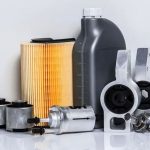Notice: Undefined index: sith_hide_share in /www/sites/alloy.wiki/index/wp-content/themes/likegoogle/single.php on line 32
Deprecated: get_settings is deprecated since version 2.1.0! Use get_option() instead. in /www/sites/alloy.wiki/index/wp-includes/functions.php on line 4862
Summarizing coppers advantages, both as primary metal and recycled metal, for brazed, long-life radiators and radiator parts for tomorrows cars and trucks:
1. Virtual 100% recyclability supported by well-established, worldwide reclamation infrastructure.
2. Low energy consumption in manufacturing and refining compared to aluminum.
3. Superior thermal conductivity, corrosion resistance and strength.
4. New no-flux brazing method of assembly.
Copper is used throughout this article to include the primary metal and its alloys.
Regaining Market with New Technologies
Throughout automotive history, copper has been the metal of choice for car and truck radiators.
This is as true today as ever, even though aluminum has assumed a significant market share in original equipment (OE) radiators over the past 20 years. Copper holds 39% of the total OE radiator market worldwide, and 89% of the aftermarket.
Moreover, with the application of several new technologies to the manufacture of advanced copper radiators, the metal may soon regain shares of the OE market lost to aluminum since the 1970s.
Using no-flux brazing and innovative tube and fin designs, these breakthrough radiators could have a 10-year life and provide up to a million miles of service. Currently being field tested by major automotive companies, they will be 30% – 40% lighter than traditional copper radiators.
In addition, they will be easy to produce because they can be made with the same operations and equipment used for brazed aluminum, thereby eliminating the need for large investments by manufacturers.
The Recycling and Environmental Edge
Increased interest in copper for radiators is also the result of a growing appreciation among industry experts of the metals environmental friendliness:
1. Copper is virtually 100% recyclable.
2. Copper has very low energy consumption in manufacture and refining.
Historically, these qualities have been taken for granted, but with the explosive growth in the “greening” of manufacturing they have taken on new meaning.
The automotive industry, in particular, wants the most environmentally compatible materials and processes for the next generation of cars and trucks. Companies such as Daimler-Benz, for example, are teaming up with suppliers to develop the concept of total metallurgical recycling. Both as primary metal and scrap for and from radiators, copper is a natural fit.
Advantage as Primary Metal
Coppers inherent superiority in thermal conductivity, corrosion resistance and strength has made it a preferred primary metal for radiators since the dawn of cars and trucks.
Now, with new technologies, it can be used to make smaller, lighter and stronger copper radiators. These radiators will be far more environmentally friendly because they are lead free and easier and cleaner to produce.
Made with a non-toxic, low temperature allow based on the CuNiSnP system, they can be brazed in the same vacuum and controlled atmosphere furnaces used for aluminum radiators and at the same temperature (approx. 600°C). And since flux isn’t present, cleaning after brazing isn’t needed and no dangerous metals remain in the brazing material.
The radiators will be theoretically coated, thereby eliminating the dangers and airborne byproducts of conventional, cosmetic spray painting. The “E” coating enhances their external corrosion protection by providing an even distribution of waterborne paint throughout the entire external structure, including previously unprintable areas within the innermost recesses of the core.
Coppers inherent superiority in thermal conductivity, corrosion resistance and strength has made it a preferred primary metal for radiators since the dawn of cars and trucks.
Now, with new technologies, it can be used to make smaller, lighter and stronger copper radiators. These radiators will be far more environmentally friendly because they are lead free and easier and cleaner to produce.
Made with a non-toxic, low temperature allow based on the CuNiSnP system, they can be brazed in the same vacuum and controlled atmosphere furnaces used for aluminum radiators and at the same temperature (approx. 600°C). And since flux isn’t present, cleaning after brazing isn’t needed and no dangerous metals remain in the brazing material.
The radiators will be theoretically coated, thereby eliminating the dangers and airborne byproducts of conventional, cosmetic spray painting. The “E” coating enhances their external corrosion protection by providing an even distribution of waterborne paint throughout the entire external structure, including previously unprintable areas within the innermost recesses of the core.
Guest contributors are welcome at the Alloy Wiki.It is a weekly wiki and guide on alloy information and processing technology, while also about the vast array of opportunities that are present in manufacturing. Our team of writers consists of a Machining Material Supplier / Machinist / Tool and Die Maker, a Biomedical Engineer / Product Development Engineer, a Job Development Coordinator / Adjunct Professor, and a President and CEO of a manufacturing facility.
Link to this article:Recyclability and Energy Efficiency:The Case for Copper in Car and Truck Radiators
Reprint Statement: If there are no special instructions, all articles on this site are original. Please indicate the source for reprinting:Alloy Wiki,thanks!^^


